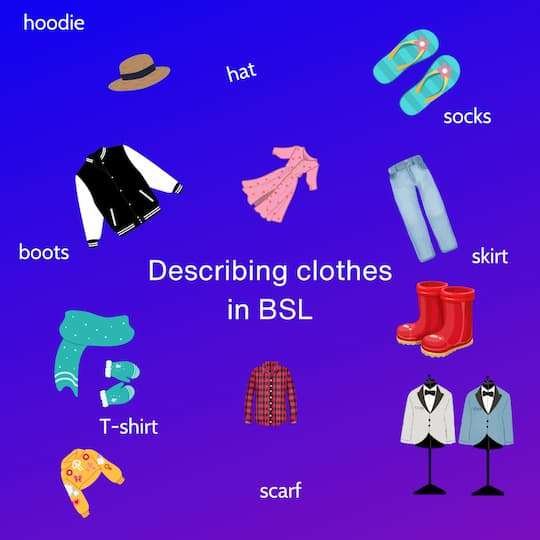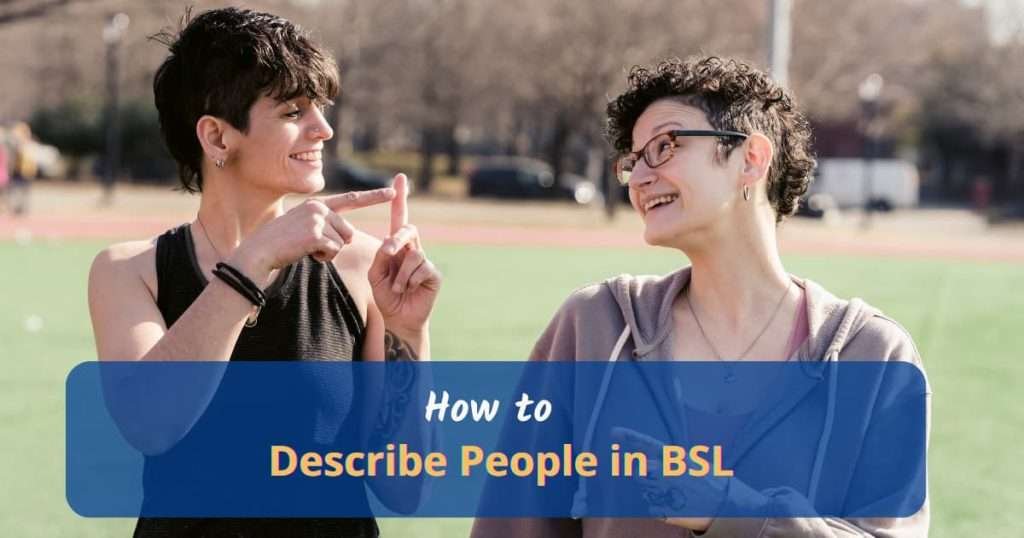Describing people in BSL is an essential skill for effective communication and understanding. Whether you are a beginner or looking to expand your BSL vocabulary, this guide will give you the correct signs to describe people accurately.
Why Describing People Correctly Matters
BSL is a visual language, and describing someone’s appearance is part of deaf culture. For example, you may be in a conversation with a deaf person and need to describe someone you met. A deaf person may ask you to describe that person. They may be able to identify who you are describing from a particular sign you use (as it may be a person’s sign name).
By mastering the art of describing people, you can engage in a meaningful conversation. You’ll also be more confident participating in the Deaf community.

The Basics of Describing People in BSL
What is the BSL sign for person? There are different ways of using signs to represent a person. You can use the C handshape or use your index finger when describing a person moving.
How do you sign people in BSL?
There are regional variations for the sign ‘people’. The same rule above applies: you can use the C handshape multiple times or different handshapes depending on the quantity of people you are describing.
Facial expressions
Describing people in sign language involves facial expressions, head movements and body movements. Many learners who are new to BSL feel silly doing facial expressions.
It is important to remember your body language, including your facial expressions, needs to show information visually so a deaf person can understand what you are signing.
The video from Two-point-four shows the signs and facial expressions needed to describe people in BSL:
The various aspects of appearance to consider are:
- physical characteristics such as hairstyle, hair colour, height, weight, eye colour and skin colour
- age & gender
- clothes & accessories
- ethnicity
- personality traits and emotions
1. Describing Physical Characteristics in BSL
Physical characteristics play a significant role in describing people. These include height, weight, hair colour, eye colour, and distinguishing features like glasses, tattoos, or piercings. To describe height, you can use appropriate signs to indicate a person is tall, short, or average height.
A person’s sign name may refer to a physical characteristic, e.g. describing ‘John with the glasses.’
Description vocabulary in British Sign Language includes: pretty, sweet, shy, beautiful, ugly, young, old, bald, straight hair, curly hair, short hair, thick hair, dry hair, soft hair, pretty eyes, narrow eyes, small eyes, big eyes, small beard, long beard, moustache, feet (big, small) legs (short, tall), slim, fat, muscles, spots, freckles
2. Describing Age and Gender in BSL
Describing age and gender is necessary when discussing individuals. You can use signs to indicate different age groups, such as children, teenagers, adults, or seniors. Additionally, signs for male and female can be incorporated into your descriptions to provide clarity.
You will need description vocabulary in BSL. Here are a few examples: age, gender, baby, toddler, child, teenager, young, middle-aged, old.
Tutor Tip: Use the age timeline to explain if a person is a child, teenager or adult
Gender identity can be a sensitive topic. There are specific signs relating to gender. The key point to remember is don’t assume a specific gender and use the gender the deaf person uses.
What is the BSL sign for girl or female?
The signs for girl and female in BSL are slightly different. As with language generally, these signs may develop and change over time.
What is the BSL sign for boy or male/man?
The sign for ‘man’ in BSL usually refers to someone with a beard. Obviously, not all men have beards. Again, this is a stereotypical sign. Language reflects changes in society so this sign may change in the future.
BSL signs for other genders such non binary or transgender can be found at Deaf Rainbow.
3. Describing Clothes and Accessories in BSL

Clothing and accessories contribute to a person’s overall appearance. Describing clothing items, colours, patterns, and accessories can help paint a vivid picture. Be sure to learn signs for different types of clothing, such as shirts, pants, dresses, and shoes, as well as accessories like hats, bags, or jewellery.
4. Describing Ethnicity in BSL
Ethnicity can be broken down into different categories. You can describe skin colour as black, white or brown.
Describing place of origin can be signed by explaining your country of origin. For example, you could sign: Born where? Ukraine Websites such as Spread the Sign are useful for finding BSL signs for countries. You can also use the site to find words in different sign languages from around the world.
Some signs are more cultural based. However, some of these signs are also (now) seen as offensive. Learning from a Deaf tutor will enable you to learn the culturally appropriate signs to describe a person’s ethnicity.
Cultural Sensitivity in BSL
When describing people in BSL, be aware of culturally sensitive signs. Older deaf community members may use certain signs that are now regarded as insensitive. This was never the intention; many older signs are based on stereotypes. Many of these signs have changed. Nonetheless, be mindful of the signs you use when communicating with a deaf sign language users.
5. Describing Personality traits in BSL
You use facial expressions to show some personal traits. For example, friendly, happy, grumpy. BSL signs for personality traits do not work without facial expressions.
YouTube: Feelings and emotions in BSL
Resources for describing people in BSL
Books:
Describing People in BSL by Cath Smith
Before you go…
Here are some other articles you might find useful:

